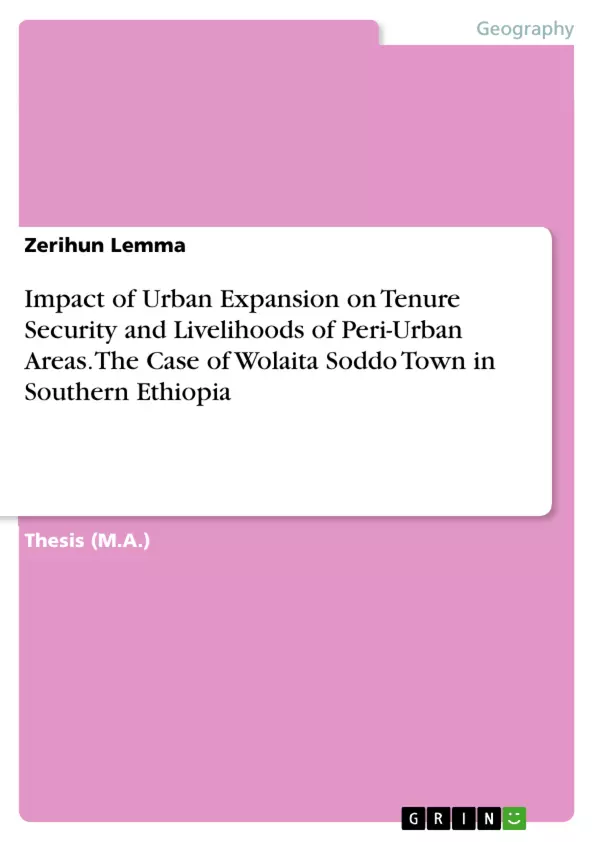This study is carried out to assess the impact of urban expansion on tenure security and livelihoods in peri-urban areas. Tenure insecurity and livelihood problems due to urban expansion are a more significant issue in the developing countries than in the developed countries in the urban periphery. Ethiopia has created a mounting competition for peri-urban land located adjacent to towns and cities by people of diverse backgrounds. As a result of these pressures rapid socio-economic problems have occurred.
This paper is aimed to assess the impacts of urban expansion on tenure security and livelihoods on the communities around Wolaita Soddo Town. Descriptive research designs as well a qualitative and quantitative research approaches were employed. Both probability and non-probability sampling methods were used to get potential respondents and the sample size was determined using the sampling distribution of proportion method, hence 120 participants were selected (85% (102) male and 15% (18) female participants).
Based on the collected data the analysis was done using SPSS and Microsoft Excel and the data was presented by different data presentation tools like tables and graphs. The results from the study revealed that the expansion of Wolaita Soddo Town has presented constraints and opportunities to people living in peri-urban areas. About 94 percent of the households responded that there is tenure insecurity. Due to having insecurity in their farm, their income has decreased.
Similarly, the study revealed, that because of the town expansion, the peri-urban community experienced a multitude of livelihood problems: e.g. loss of assets due to periodic land displacement, reduction of farmland and great fear. On the other hand, the increase in non-farm job opportunities and infrastructure development in the studied areas are noteworthy. The development of new livelihood activities has culminated in the adoption of both farming and non-farming livelihood strategies.
Inhaltsverzeichnis (Table of Contents)
- Acronomy and Abbreviations
- List of tables
- List of figures
- Acknowledgment
- Abstract
- Introduction
- Background of the Study
- Statement of the Problem
- General objective
- Specific objectives
- Significance of the Study
- Scope of the study
- The limitation of the Study
- Litrature Review
- Basic Concepts of Urbanization
- Causes of urban expansion
- Trends of urban expansion
- The impacts of urban expansion
- Land Rights
- Tenure Security
- Overview of land tenure in Ethiopia
- Empirical Evidences on the Impact of Urban Expansion on Tenure Security
- Impacts of Urban Expansion on Livelihood of Peri-urban Areas
- RESEARCH METHODOLOGY
- DESCRIPTION OF THE STUDY AREA
- The Conceptual frame work of this Study
- Research Strategy and Design
- Research Design
- Sampling Design
- Source of Data
- Techniques of Data Collection
- Methods of Data Analysis and Presentation
- CHAPTER FOUR
- RESULTS AND DISCUSSION
- Demographic and Socio economic Characteristics of Sampled Household
- Impacts of Urban Expansion on Tenure Security
- Impacts of Urban expansion on farmers' financial capital
- Before Expansion
- After Expansion
- Impacts of Urban Expansion on Farmers' Social Capital
- Impacts of urban expansion on farmers' natural capital
- Urban expansion impact on farmers' physical capital
- Perception of Farming Community towards Urban Expansion
- Strategies Adopted to Cope with the Effects of Urban Expansion
- CHAPTER FIVE
- CONCLUSION AND RECOMMENDATION
- CONCLUSION
- Recommendations
Zielsetzung und Themenschwerpunkte (Objectives and Key Themes)
This thesis aims to investigate the impact of urban expansion on tenure security and livelihoods in peri-urban areas, focusing on Wolaita Sodo town in southern Ethiopia. The research specifically examines how urban expansion affects land rights, access to resources, and income-generating opportunities for local communities.
- The impacts of urban expansion on tenure security and land rights in peri-urban areas.
- The influence of urban growth on the livelihoods and income-generating opportunities of peri-urban households.
- The strategies adopted by peri-urban communities to adapt to the challenges posed by urban expansion.
- The role of land administration and policy in mitigating the negative impacts of urban expansion on peri-urban communities.
- The importance of sustainable urban planning to balance economic development with the needs of rural communities.
Zusammenfassung der Kapitel (Chapter Summaries)
The introductory chapter presents the background of the study, outlining the problem of urban expansion and its potential impact on peri-urban communities. It also establishes the research objectives, significance, and scope of the study. Chapter two provides a comprehensive literature review, covering the concepts of urbanization, land rights, and tenure security, with a specific focus on the Ethiopian context. It examines the impacts of urban expansion on tenure security and livelihoods, drawing from existing empirical evidence. Chapter three details the research methodology employed, including the description of the study area, the conceptual framework, the research strategy and design, data collection methods, and data analysis techniques. Chapter four presents and analyzes the results of the study, focusing on the demographic and socioeconomic characteristics of the sampled households, the impacts of urban expansion on tenure security, and the changes in peri-urban household livelihoods. The chapter also explores the strategies adopted by communities to cope with the effects of urban expansion.
Schlüsselwörter (Keywords)
This research focuses on the complex interplay between urban expansion, tenure security, and livelihoods in peri-urban areas. Key concepts explored include urbanization, land rights, tenure security, peri-urban communities, livelihood diversification, and sustainable urban planning.
- Citation du texte
- Zerihun Lemma (Auteur), 2020, Impact of Urban Expansion on Tenure Security and Livelihoods of Peri-Urban Areas. The Case of Wolaita Soddo Town in Southern Ethiopia, Munich, GRIN Verlag, https://www.grin.com/document/947213



